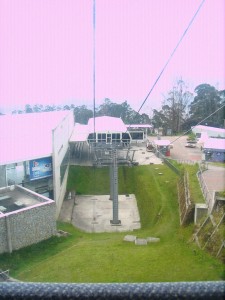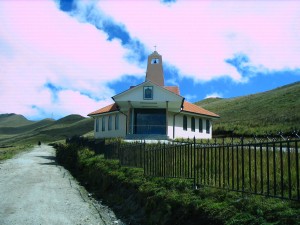Ecuador Travelogue (part 4)
By the way, Zazu was the only five-star restaurant we’ve ever been to, and it was stupendous. The sushi, on the other hand, was not as good as it was four years ago. But it gave us enough sustenance to get up relatively early on Saturday morning and take off for Otovalo.
Everyone we talked to said Otovalo was cercita – only an hour and a half away. Eileen thought she remembered it being longer than that; I had no idea. But the bus driver sided with Eileen in asserting that the trip was closer to 2 ½ hours. Throw in a little confusion over where to catch the bus and it really ended up being a 3 ½ or 4-hour saga.
I take solace in the fact that we bargain better than most other gringos, though. Hammocks that were selling for $18 at most places we got for $25 for 2! And Eileen got lots of earrings and scarves for some great prices. But the most memorable part of the trip came before we purchased the hammocks, when a familiar-looking gray-haired gringo walked by and I said to Eileen, “I think I know that guy.” He disappeared quickly, but 15 minutes later I figured out how I knew him. We rounded a corner and there before us, finishing up a purchase with a vendor, stood a former student of mine! That gray-haired gringo was his father, whom I remembered from our one and only meeting at parent-teacher conferences last fall.
On this visit to Ecuador, we allowed ourselves to spend money more like tourists. When we lived here, making a combined salary of $700 a month, we were hesitant to ever drop more than ten dollars in one sitting. (We only went to the Swiss Hotel on Friday nights, when the rolls were two for the price of one.) In fact, I vaguely remember debating whether or not to go to the butterfly museum in Mindo because we thought it was expensive ($6 per person!). But now we were okay with spending $10 for the Canopy Adventure and $8 for the ride up the Teleferico’s cable cars in Quito.
The Teleferico was built while we lived here; it was completed in June of 2005, I think. And while Eileen braved the huge crowds in the opening weeks, waiting in line for something like 3 hours, I never got the chance to go. So on Monday morning, we walked up La Gasca, toward the barrio known as Las Casas, where we could catch a free bus to the Teleferico park. There, we paid the $8 admission fee (for foreigners), and got into a cable car without wait. No line whatsoever. We had gone relatively early (8:30) on the advice of a former student of mine, and it was a pretty good move.

At the top of the lift, there’s a small park with some dirt trails you can hike on. There’s also a church for some reason. The elevation was somewhere around 13500, and it took some effort to walk up steep hills. So I began joking that the church was called Our Lady of I Can’t Breathe. I came up with some good names (Nuestra Senora de la Falta del Oxigeno, Nuestra Dama de la Achachay, La Iglesia de Ayudame), but they were sacrilegious, Ecuadorian Spanish jokes, so I’ll spare you the full list. Trust me, though: they were funny. Really funny.

